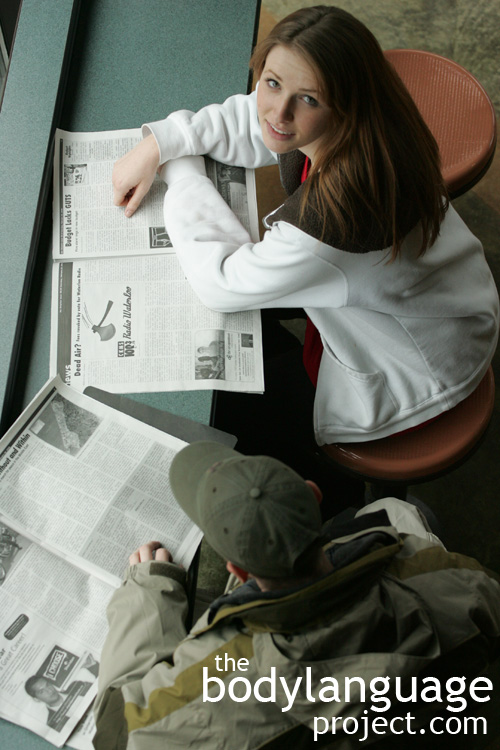Body Language of Loving Circle Leg Cross
Synonym(s): N/A
Description: When lovers, family members, or associates sit on a couch or in chairs close together, and orient their legs toward each other forming a closed loop. The arms can sometimes meet over the backs for the couch. This gives the impression of a system that is closed off from others.
In One Sentence: The loving circle signals the desire to be close and create an intimate area at the exclusion of others.
How To Use it: Use the loving circle to show partners that you are focused wholly on them and don’t want other people to interfere or distract from what is being cultivated between the two of you. This can work between family members, but is best done between intimate couples. Close friends can also use the loving circle to be totally immerse in each others presence. When viewed by other people it signals the desire not to be interrupted so this can work to repel unwanted outside conversations.
Context: a) General b) Dating.
Verbal Translation: “We agree and are close. We are so united that we are forming our bodies into a barrier preventing others from penetrating our social circle.”
Variant: See Leg Crossing and Leg Crossing Direction.
Cue In Action: a) The husband and his wife sat on the sofa with their legs crossed toward one another in a sea of unfamiliar people at a social gathering. They used their bodies to protect themselves from the unfamiliar. Their daughter snuggled up in between them. b) A young couple grew more intimate as the night wore on. Near the middle of the night, they had formed a loving circle by crossing their legs toward one another coupled with hand-in-hand over the back of the sofa.
Meaning and/or Motivation: The loving circle can happen within families, with close friends, associates and between and amongst the sexes. It signifies agreement, unity and commonality.
The legs and arms create a closed barrier which prevents other people from getting close or breaking into the conversation. When lovers perform this posture they signify intimacy and a desire for privacy and isolation from outside intruders.
Cue Cluster: Often the loving circle includes leaning in, eye contact, and touching.
Body Language Category: Barriers, Courtship displays, Indicator of interest (IoI), Liking, Orienting reflex or orienting response (a), Ownership gestures, Seating arrangements.
Resources:
Aiello, J. 1977. A further look at equilibrium theory. Visual interaction as a function of
interpersonal distance. Environmental Psychology & Nonverbal Behavior, 1: 122-140.
Astrom, Jan. Introductory greeting behavior: a laboratory investigation of approaching and closing salutation phases. Perceptual and Motor Skills. 1994. 79(2): 863(35).
Argyle, M., & Dean, I. Eye contact, distance and affiliation. Sociometry, 1965, 28, 289-304.
Baxter, James C. ; Rozelle, Richard M. Lanzetta, John T. (editor). Nonverbal expression as a function of crowding during a simulated police-citizen encounter. Journal of Personality and Social Psychology. 1975. 32(1): 40-54.
Boucher, Michael L. Holzberg, Jules D. (editor). Effect of seating distance on interpersonal attraction in an interview situation. Journal of Consulting and Clinical Psychology. 1972 38(1): 15-19.
Cook, Mark. 1970. Experiments on orientation and proxemics. Human Relations 23 (1): 61-76.
Chance RMA (1962) An interpretation of some agonistic postures: the role of “cut-off” acts and postures. Symp Zool Soc Lond 8: 71–89.
Coutts, Larrym. ; Ledden, Maribeth. Nonverbal Compensatory Reactions to Changes in Interpersonal Proximity. The Journal of Social Psychology. 1977 102(2): 283-290.
DeSteno, D.; Breazeal, C.; Frank, R. H.; Pizarro, D.; Baumann, J.; Dickens, L, and Lee, J. Detecting the Trustworthiness of Novel Partners in Economic Exchange. Psychological Science. 2012. 23, 1549-1556.
http://bodylanguageproject.com/articles/use-body-language-cues-create-trust
Doody, John ; Bull, Peter. Asperger’s Syndrome and the Decoding of Boredom, Interest, and Disagreement from Body Posture. Journal of Nonverbal Behavior. 2011. 35(2): 87-100.
Dowell, Nia M. and Jeffrey S. Berman. Therapist Nonverbal Behavior and Perceptions of Empathy, Alliance, and Treatment Credibility. Journal of Psychotherapy Integration. 2013. 23(2): 158-165. DOI: 10.1037/a0031421. http://bodylanguageproject.com/articles/lean-make-eye-contact-create-impressions-empathy-leaning-body-language-creates-greater-credibility
Felipe, N. Interpersonal distance and small group interaction. Cornell Journal of Social Relations, 1966, 1, 59-64.
Felipe, N. Connotations of seating arrangements. Cornell Journal of Social Relations, 1967, 2, 37-44.
Fretz, Bruce R. Counselor Nonverbal Behaviors and Client Evaluations. Journal of Counseling Psychology. 1979. 26(4): 304-11.
Genthner, Robert W. ; Moughan, James Osipow, Samuel H. (editor). Introverts’ and extraverts’ responses to nonverbal attending behavior. Journal of Counseling Psychology. 1977. 24(2): 144-146.
Girard, Jeffrey M.; Jeffrey F. Cohna; Mohammad H.Mahoor S.; Mohammad Mavadati;
Zakia Hammal; and Dean P. Rosenwalda. Nonverbal Social Withdrawal In Depression: Evidence From Manual And Automatic Analyses. Image and Vision Computing. 2013.
http://bodylanguageproject.com/articles/body-language-signals-withdrawal-depression/
Gorkan Ahmetoglu, Viren Swami. Do Women Prefer “Nice Guys?” The Effect Of Male Dominance Behavior On Women’s Ratings. Social Behavior And Personality, 2012; 40(4), 667-672.
http://bodylanguageproject.com/articles/how-to-significantly-increase-male-attractiveness-with-simple-body-language-nice-guys-finish-last-once-again/
Gregersen, Tammy S. Nonverbal Cues: Clues to the Detection of Foreign Language Anxiety. Foreign Language Annals. 2005. 38(3): 388-400
http://bodylanguageproject.com/articles/what-anxious-learners-can-tell-us-about-anxious-body-language-how-to-read-nonverbal-behavior/
Goodboy, Alan, K. and Maria Brann. Flirtation Rejection Strategies: Towards an Understanding of Communicative Disinterest in Flirting. The Quantitative Report. 2010. 15(2): 268-278.
http://bodylanguageproject.com/articles/how-to-reject-flirting-using-nonverbal-and-verbal-tactics/
Gifford, Robert ; O’Connor, Brian. Nonverbal intimacy: Clarifying the role of seating distance and orientation. Journal of Nonverbal Behavior. 1986 10(4): 207-214.
Gardin, Hershel ; Kaplan, Kalman J. ; Firestone, Ira J. ; Cowan, Gloria A. Lanzetta, John T. (editor). Proxemic effects on cooperation, attitude, and approach-avoidance in a Prisoner’s Dilemma game. Journal of Personality and Social Psychology. 1973. 27(1): 13-18.
Haase, Richard F. ; Dimattia, Dominic J. Berdie, Ralph F. (editor). Proxemic behavior: Counselor, administrator, and client preference for seating arrangement in dyadic interaction. Journal of Counseling Psychology. 1970 17(4): 319-325.
Hall, Jeffrey A. and Chong Xing. The Verbal and Nonverbal Correlates of the Five Flirting Styles. Journal of Nonverbal Behavior. 2015. 39:41–68. DOI 10.1007/s10919-014-0199-8
http://bodylanguageproject.com/articles/first-12-minutes-flirting-using-nonverbal-communication-study-reveals-26-body-language-cues-attraction/
Harrigan J. and Rosenthal R. Physicians’ head and body positions as determinants of perceived rapport. J. appl. Sot. Psychol. 13, 496, 1983.
Hall, Judith ; LeBeau, Lavonia ; Reinoso, Jeannette ; Thayer, Frank. Status, Gender, and Nonverbal Behavior in Candid and Posed Photographs: A Study of Conversations Between University Employees. Sex Roles. 2001 44(11): 677-692.
Hietanen, Jari. Social attention orienting integrates visual information from head and body orientation. Psychological Research.2002 66(3): 174-179.
Jenkins, R., Beaver, J.D., & Calder, A.J. (2006). I thought you were looking at me: Direction-specific aftereffects in gaze perception. Psychological Science, 17, 506–513.
Katza, Carmit; Irit Hershkowitz; Lindsay C. Malloya; Michael E. Lamba; Armita Atabakia and Sabine Spindlera. Non-Verbal Behavior of Children Who Disclose or do not Disclose Child Abuse in Investigative Interviews. Child Abuse & Neglect. 2012. 36: 12-20.
http://bodylanguageproject.com/articles/reading-nonverbal-behaviour-child-abuse-cases-encourage-children-divulge-information-truth-telling
Kahlbaugh, Patricia ; Haviland, Jeannette. Nonverbal communication between parents and adolescents: A study of approach and avoidance behaviors. Journal of Nonverbal Behavior. 1994 18(1): 91-113.
Kenner, Andrew N. ; Katsimaglis, George. Gender differences in proxemics: taxi-seat choice. Psychological Reports. 1993 72(2): 625(2).
Langton, S. R. H., & Bruce, V. (2000). You must see the point: Automatic processing of cues to the direction of social attention. Journal of Experimental Psychology: Human Perception and Performance, 26, 747–757.
Langton, S. R. H. (2000). The mutual influence of gaze and head orientation in the analysis of social attention direction. The Quarterly Journal of Experimental Psychology, 53A, 825–845.
Mehrabian, Albert Holzberg, Jules D. (editor). Inference of Attitudes From the Posture, Orientation and Distance of a Communicator. Journal of Consulting and Clinical Psychology. 1968. 32(3): 296-308.
Mehrabian, Albert Deese, James (editor). Significance of posture and position in the communication of attitude and status relationships. Psychological Bulletin. 1969. 71(5): 359-372.
Mehrabian, A., Friar, J., 1969. Encoding of attitude by a seated communicator via posture and position cues. Journal of Consulting and Clinical Psychology 33: 330–336.
Moore, Monica. Courtship Signaling and Adolescents: Girls Just Wanna Have Fun. Journal of Sex Research. 1995. 32(4): 319-328.
http://bodylanguageproject.com/articles/girls-just-want-to-have-fun-the-origins-of-courtship-cues-in-girls-and-women/
Mackinnon, Sean P. ; Jordan, Christian H. ; Wilson, Anne E. Birds of a feather sit together: Physical similarity predicts seating choice. Personality & Social Psychology Bulletin. 2011 37(7): 879(14).
Pinar, Rukiye ; Ataalkin, Sıddıka ; Watson, Roger. The effect of crossing legs on blood pressure in hypertensive patients. Journal of Clinical Nursing. 2010. 19(9-10): 1284-1288.
Remland, Martins. ; Jones, Tricias. ; Brinkman, Heidi. Interpersonal Distance, Body Orientation, and Touch: Effects of Culture, Gender, and Age. The Journal of Social Psychology. 1995 135(3): 281-297.
Scherer, S. E., & Schiff, M. R. Perceived intimacy, physical distance, and eye contact. Perceptual and Motor Skills, 1973, 36, 835-841.
Scott, J. A. Comfort and seating distance in living rooms: The relationship of interactants and topic of conversation. Environment and Behavior, 1984, 16, 35-54.
Sommer, R. Studies in personal space. Sociometry, 1959, 22,247-260.
Sommer, R. The distance for comfortable conversation: A further study. Sociometry, 1962, 25, 111-116.
Sommer, R. Personal space: The behavioral basis of design. Englewood Cliffs, New Jersey: Prentice Hall. 1969.
Trout, Deborah ; Rosenfeld, Howard. The effect of postural lean and body congruence on the judgment of psychotherapeutic rapport. Journal of Nonverbal Behavior. 1980. 4(3): 176-190.
Underwood, M. K.. Glares of Contempt, Eye Rolls of Disgust and Turning Away to Exclude: Non-Verbal Forms of Social Aggression among Girls. Feminism & Psychology. 2004 14(3): 371-375.
Willis, F. 1966. Initial speaking distance as a function of the speaker’s relationship.
Psychonomic Science. 5: 221-222.
Weiss, M., & Keys, C. The influence of proxemic variables on dyadic interaction between peers. Paper presented at the meeting of the American Psychological Association; Chicago, 1975, August.



